The aim of this paper was to analyze the economic performance of the United Arab Emirates (UAE). In particular, the paper focused on the effect of the decline in economic growth rate in 2012 and the fiscal policy that can be implemented to boost economic growth. The IMF predicted a reduction in economic growth of the country from 4.9% in 2011 to 2.3% in 2012. The country’s limited capacity to increase oil production is one of the factors that were expected to cause the decline in economic growth.
The findings of this paper indicate that the reduction of economic growth rate would reduce the country’s real output and increase unemployment in the long-run. Consequently, the government should implement an expansionary fiscal policy in order to stimulate economic growth. Moreover, the government should focus on controlling the inflation and the crowding-out effect associated with expansionary fiscal policy.
Summary of the Article
According to the International Monetary Fund (IMF), the expansion rate of the economy of the United Arab Emirates (UAE) was expected to reduce from 4.9% in 2011 to 2.3% in 2012. The reduction was attributed to the country’s inability to increase its oil production. Nonetheless, the economy was expected to maintain its recovery.
The 2009-2010 Dubai debt crisis adversely affected the country’s property industry. Consequently, Dubai World, which is a state-owned corporation, had to restructure its debts that were worth twenty five billion dollars. Nonetheless, the country was able to survive the crisis due to favorable oil prices and improved trade with Asia.
According to the IMF, the uncertainty of the performance of the world economy was a threat to UAE’s forecasted growth. Concisely, continued decline in the performance of the world economy would limit the ability of UAE’s state-owned corporations to replace their maturing debts with new ones. Despite the efforts made to restructure the debts, most state-owned corporations still required high refinancing. The IMF also believed that the government’s decision to consolidate fiscal policy was right.
Explanation of the Article based on AD-AS Model
The economy of the UAE as described in the article can be explained in the framework of the aggregate demand (AD) and aggregate supply (AS) model. The model is made of up of three curves namely, the “aggregate demand curve (AD), the short run aggregate supply curve (SAS) and the long run supply curve (LAS)” (Rossana 81).
Figure 1 shows the short run equilibrium of the economy of the UAE. Aggregate demand includes consumption by private economic entities, investments, government expenditure, and net exports (Chamberlin, Linda and Yueh 241). In this regard, the factors that will cause a shift in the AD curve of UAE’s economy include foreign income, income distribution, and fiscal policy, as well as, anticipations concerning future output and prices.
Foreign income refers to the income earned in UAE’s major trading partners such as the United States of America, Europe, and Asian countries. According to the article, the recovery of the global economy is uncertain. This implies that foreign income will reduce if the global economy continues to deteriorate. Thus, the demand for UAE’s exports such as oil will reduce. As a result, the earnings of UAE’s exporting firms will decrease.
This partly explains why the state-linked firms will not be able to rollover their debts if the performance of the global economy worsens. Overall, the decline in foreign income will cause the AD curve to shift to the left from AD0 to AD1, thereby reducing real output from Y0 to Y1.
Following IMF’s prediction of economic decline, producers expect demand for their products to reduce in future. Thus, they will reduce investments and production in order to avoid the losses associated with high variable costs and low demand (Rossana 126). Similarly, consumers will associate the expected economic decline with reduced future earnings.
Thus, they are likely to reduce consumption in order to save for the future. Consequently, the AD curve will shift to the left from AD0 to AD1, whereas real output will reduce from Y0 to Y1.
As firms reduce investments and production in response to the expected economic decline, the “distribution of income from profit earners to wage earners is likely to worsen” (Minford and Peel 329). Generally, wage earners allocate a larger portion of their income to consumption than profit earners.
Thus, allocation of income in favor of profit earners rather than wage earners will move the AD curve to the left. Finally, the government’s plan to consolidate fiscal policy is likely to involve a reduction in public expenditure. This will lower aggregate demand, thereby shifting the AD curve to the left.
The SAS illustrates the response of prices and real output to changes in aggregate demand in the short run (Romer 415). UAE’s short run supply curve will shift due to changes in productivity. The expected economic decline will lead to reduced productivity, thereby shifting the SAS curve in figure 2 to the left from SAS0 to SAS1.
Additionally, real output will reduce from Y0 to Y1. If the global economy continues to deteriorate, the prices of UAE’s exports will decline. This will discourage production among exporters, thereby reducing aggregate supply. Thus, the SAS curve will shift to the left.
The expected decline in economic growth will cause the aggregate supply curve and the aggregate demand curve to shift to the left. These shifts are associated with a reduction in real output from Y0 to Y1. As a result, the short run equilibrium of the country’s economy will shift from E0 to E1.
Description of the Economic Situation of the Market
The expected decline in economic growth will affect both the goods and factor markets. In the goods market, the economic decline can have positive effects for consumers. This is because inflation usually declines when economic growth reduces (Rossana 112). Concisely, economic decline reduces demand for goods and services.
Thus, producers and sellers are likely to reduce the prices of their products in order to stimulate demand and to clear their stock of manufactured goods, thereby reducing inflation. In this case, the consumers will have a higher purchasing power than they had before the reduction of the prices. On the contrary, the price reductions will affect the producers negatively. This is because it will reduce their profit margins. In addition, some producers might sell their goods at a loss.
The expected economic decline will also affect prices in the factor market. As profits reduce, companies are likely to implement cost-cutting measures such as reducing their workforce. Moreover, companies are likely to reduce their investments in new equipment or borrowing in order to expand their operations (Minford and Peel 215).
In this regard, factor prices will fall. For example, wage rates are likely to reduce as companies layoff their employees. Similarly, interest rates, which is the cost of financial capital is likely to reduce as demand for loans declines. The reduction in factor prices will benefit producers by lowering their costs of production. Nonetheless, it will negatively affect suppliers of factors of production. For example, low wage rates will reduce workers’ disposable income and purchasing power.
The Right Fiscal Policy
Fiscal policy refers to the use of “government expenditure, taxation, and borrowing to influence the level of aggregate demand, output, and jobs in an economy” (Chamberlin, Linda and Yueh 197). Fiscal policy enables the government to influence the pattern of expenditure and income distribution in its economy.
Thus, Keynesians believe that fiscal policy has a great impact on consumption, productivity, and job creation in an economy that has an excess capacity. Thus, the government of the UAE should implement an expansionary fiscal policy in order to prevent a recession. An expansionary fiscal policy refers to “the increase in government expenditure and or a decrease in taxes that usually results into an increase in budget deficit or a reduction in budget surplus” (Chamberlin, Linda and Yueh 210).
Justification for Implementing Expansionary Fiscal Policy
An expansionary fiscal policy should be implemented because it will enable the government to reverse the economic decline. Concisely, the policy will spur economic growth by stimulating consumption and demand. The unemployment rate in the UAE increased from 3% in 2008 to 4.2% in 2012 (Nyarko 4-15). On the contrary, the country’s inflation rate was as low as 0.7% in 2012.
The increase in unemployment rate, low inflation, and the expected reduction in GDP growth suggest that the economy is operating below its potential output. The government can push the country’s real output back to its near potential level by implementing an expansionary fiscal policy that involves an increase in public spending. Government “expenditure is one of the components of aggregate demand” (Rossana 47). Thus increasing it will result into an increase in aggregate demand.
Figure 3 shows the effect of an expansionary fiscal policy on real output. According to figure 3, a rise in aggregate demand due to an increase in spending by the government will move the AD curve to the right from AD0 to AD1. Consequently, the country’s real output will increase from Y0 to Yp. In this case, Yp is the potential output. As the economy moves towards its potential output, the rate of GDP growth is likely to increase.
How the Expansionary Fiscal Policy will affect the Economy
First, the policy will lead to increased economic growth, thereby improving earnings in the private and public sector. Concisely, firms are likely to increase investments and to employ more people in order to increase their production in response to the expected increase in aggregate demand (Rossana 233).
In this regard, increased productivity will raise firm profits and the incomes earned by workers. The government can also create employment through the expansionary fiscal policy. For example, it can create thousands of jobs in the construction industry by constructing new roads and schools.
Second, an expansionary fiscal policy is likely to be inflationary. Figure 3 shows that prices will increase from P0 to P1 as real output increases after the implementation of the expansionary fiscal policy. A sharp increase in inflation is not desirable because it will reverse the benefits of the economic growth. Concisely, a high inflation reduces consumers’ purchasing power.
Thus, aggregate demand will reduce if wages are not raised in response to the increase in inflation (Minford and Peel 316). Similarly, a high inflation will raise the prices of inputs, thereby increasing production costs. If the producers are able to pass the high costs of production to consumers, the prices of various goods and services will increase, thereby reducing demand. However, producers will have to absorb the high costs of production if they cannot share them with the consumers.
In this case, firm profits will reduce in response to the high production costs. Nonetheless, the inflationary effect is not likely to be severe because the country’s inflation in 2012 was less than 1% (World Bank). Countries can increase their economic growth rate and create employment as long as they maintain a single digit inflation rate (Rossana 102). Thus, the inflation associated with the expansionary fiscal policy is not likely to be detrimental if it is less than 10%.
Third, the expansionary fiscal policy is likely to increase UAE’s public debt if it is financed through borrowing. In 2012, the country’s public debt as a percentage of its GDP was 40%. Thus, the country is likely to fall into a debt trap if it continues to increase its public debt. A debt trap is a situation in which the government has to borrow in order to pay the interests charged on its existing debts. Countries that have fallen into debt traps often have poor credit ratings due to their limited ability to repay their loans.
Thus, a low credit rating will limit the country’s ability to access capital from foreign lenders such as the IMF. High public debt is also not desirable because it involves a redistribution of income from taxpayers to holders of government debt securities (Romer 516). In this regard, it is likely to redistribute income from low-income earners who pay taxes to the rich who invest in government bonds. This is because the interests on government bonds are paid through taxes.
Fourth, an expansionary fiscal policy is likely to have a crowding-out effect in the economy if it is implemented through a large deficit spending. In this case, the government will have to borrow a large amount of financial capital from the public in order to implement the policy. Conceptually, the government will be competing with private firms for capital.
Consequently, interest rates will increase, thereby limiting the ability of private firms to access credit through the financial and capital markets. The government will have to increase taxes in order to repay the funds borrowed from the public. High taxes in the medium run will reduce consumers’ disposable income (Minford and Peel 117). The resulting reduction in consumption and demand, as well as, limited access to capital will lead to reduced investments. Thus, economic growth will decline.
The Fiscal Policy Tools
The tools that should be used to implement expansionary fiscal policy are increased government spending and tax cuts. Increased government expenditure can be implemented in the following was. First, the government can increase its transfer payments. This involves increasing expenditure on social security programs such as unemployment benefit, state pension, and grants to students.
Transfer payments ensure that every citizen has access to some minimum regular income (Minford and Peel 391). Transfer payments will improve the purchasing power of the poor, thereby increasing aggregate demand and economic growth.
Second, the government can expand its current budget on recurrent expenditure. This involves increasing expenditure on public goods such as education and health care. In this regard, the government can increase employment in the education and health sector by hiring more teachers and nurses respectively. Additionally, the government can improve the salaries of workers in the sectors that provide public goods.
Provision of public goods also involves expenditure on consumables such as stationery. Thus, aggregate demand is likely to increase as the government increases its expenditure on public goods. This will lead to improved economic growth.
Finally, government expenditure can be increased through capital spending. This involves increasing investments on infrastructure such roads, schools, and hospitals. Capital spending has a great effect on aggregate demand and supply because it stimulates high consumption.
For example, construction of new roads will increase demand in the industries that supply construction materials. In addition, construction projects usually create thousands of employment opportunities. This will help the country to address the problem of persistent unemployment.
Taxes can be direct or indirect. Direct taxes are charged on employment income and profits. Indirect taxes are levied on spending. They include value added tax (VAT) and excise duties on goods such as petrol. Most residents of the UAE do not pay personal income tax. Nonetheless, corporate tax is charged in most of the emirates.
For example, nearly all companies in Dubai pay taxes on their earnings. In Dubai, corporate tax can be as high as 55% (Nyarko 4-15). Generally, most emirates levy corporate taxes on foreign oil companies, petrochemical firms, and foreign banks. These companies pay up to 55% of their operating profits as income tax to the government.
Even though most residents of the UAE are exempted from income tax, they usually pay several indirect taxes. For example, municipal taxes of between 5% and 10% are usually levied on revenue generated from entertainment services, hotel operations, and commercial premises (Nyarko 4-15).
In addition, most imported goods are subject to an import duty of up to 5%. Thus, the government can still implement the expansionary fiscal policy by reducing indirect taxes that are levied on consumption. For example, a reduction of taxes on entertainment and hotel rooms can lower the cost of staying in hotels.
Consequently, hotel occupancy will increase, thereby raising the income of hotel owners and securing jobs in the hotel and restaurant industry. In addition, the government can reduce the corporate taxes that are paid by foreign oil and bank companies in order to improve their earnings. Lower taxes will enable these companies to allocate a better part of their earnings to investments rather than paying taxes. This will increase their productivity, thereby promoting economic growth.
Impact of the Fiscal Policy Tools in the Economy
Increased Government Expenditure
Increased government spending will benefit the economy in the following ways. First, capital spending will lead to an increase in the total assets of the state. In particular, it will lead to expansion of the infrastructure that is necessary for the growth of businesses in the country.
For example, the expansion of roads and railway systems will improve efficiency in transportation. The resulting reduction in the cost of transportation will reduce the overall cost of producing goods and services in the economy. According to figure 4, a reduction in the cost of production shifts the aggregate supply curve downwards, thereby increasing real output from Y1 to Y2.
This shows that investments on infrastructure that support economic activities will lead to high economic growth. Furthermore, foreign direct investments are likely to increase if capital spending is used to expand the country’s infrastructure. For example, more airlines are likely to operate form Dubai if its airport is expanded. This will create more jobs and spur economic growth through increased consumption.
Second, provision of public goods and services such as education and health care will have positive supply-side effects in the economy by improving the quality of the country’s human capital. For example, funding higher education through grants to students will enable more people to improve their technical skills. People with high academic qualifications are likely to be highly productive because they have the knowledge and skills that are necessary for achieving innovation (Al-Khateeb, Darrat and Elkhal 297-306).
Similarly, spending on youth apprenticeship programs will enable fresh graduates to gain adequate job experience, thereby improving their employability. Concisely, it will enable the government to improve the competitiveness of the youth in the job market in order to reduce unemployment in the country. Similarly, expenditure in the health care sector will improve the health status of the citizens, thereby improving their productivity.
Third, expanding social safety net programs is an effective way of improving the incomes of the poorest people in the country. By 2012, nearly 10% of the population of the United Arab Emirates was living in poverty (World Bank). Improving the income of the population living in poverty through transfer payments will boost consumption. The resulting increase in demand for goods and services will encourage producers to increase their output through new investments.
Transfer payments are also a means of income and wealth redistribution in the economy. This is because transfer payment programs are financed through taxes, which are often paid by the rich. The benefit of redistributing income from the rich to the poor is that it enhances equality in the economy. Additionally, reducing income disparity reduces the chances of social unrests, which can hinder productivity and economic growth.
Tax Cuts
Tax cuts will affect the economy in the following ways. To begin with, reducing corporate tax will enhance investment in the economy. The oil and gas sector contributes approximately 31.3% of the GDP of the United Arab Emirates (Nyarko 4-15).
Nonetheless, companies in this industry, especially, the foreign ones pay nearly 55% of their operating profits as taxes. This reduces the amount of funds that firms in the industry can allocate to investments and expansion. According to the article, reduced production in the oil and gas industry is one the factors that were expected to slow the country’s economic growth.
However, productivity in the industry can be improved by lowering taxes in order to enable firms to allocate a large portion of their earnings to investments. For instance, firms in the industry can focus on oil exploration, thereby increasing the country’s oil and gas output. Any small increase in productivity in the oil and gas industry is likely to have a great multiplier effect in the economy. This is because the industry employs thousands of people and supplies oil, which is the main source of energy for production in the country.
Lowering taxes is also likely to attract foreign direct investments in the country. Foreign investors often invest in countries that provide tax incentives so that they can improve their earnings. An increase in foreign direct investments will have a powerful demand-side effect in the economy. Concisely, the consumptions associated with new investments by foreign investors will increase the demand for various goods and services in the economy.
The increase in demand will encourage producers to increase their output, thereby increasing the country’s GDP (Rossana 88). Finally, reducing the level of compulsory pension contribution will improve the purchasing power of the citizens. Concisely, a reduction of the compulsory contributions will enable the citizens to have a high disposable income, which will enable them to purchase more goods and services.
Impact on Macroeconomic Indicators
The article highlights three important macroeconomic factors, which have implications for the country. These include the expected reduction in GDP growth, planned fiscal consolidation, and uncertain performance of the world economy and financial markets. These factors will affect the country’s unemployment and output in the following ways.
Output
The forecasted reduction in economic growth means that the country’s output (measured by GDP) expanded at a slower rate in 2012 than in the previous year. Expectations concerning future decline in economic activity usually influence production decisions.
Producers and investors associate a reduction in the rate of economic growth with a decline in profits or corporate earnings (Romer 477). Thus, they are likely to reduce their output in response to the expected decline in demand as the economy slows down. In this regard, expectations of a decline in future earnings will lower the country’s output.
The country’s output is also likely to decline if the global economic environment continues to deteriorate. Concisely, poor performance of the world economy will reduce the demand for the country’s main exports such as oil. Thus, UAE’s exporters will reduce their output in response to the low demand for their products. Similarly, uncertainty in the global financial environment will limit the ability of UAE’s firms to access credit from foreign markets. This will limit investments and reduce the country’s output.
Fiscal consolidation involves implementing strategies that enable the government to reduce its budget deficit and overall public debt (Rossana 121). Thus, fiscal consolidation involves a reduction in public spending by the government. Reducing government expenditure is essentially a contractionary fiscal policy. According to figure 5, a reduction in government spending will cause a shift in the aggregate demand curve to the left, thereby reducing real output from Y0 to Y1. Thus, fiscal consolidation is likely to reduce the country’s output.
Unemployment
Unemployment is a lagging macroeconomic indicator because it usually takes time to respond to a change in GDP growth. Thus, the country’s unemployment rate may not change significantly in the short run as the economy slows down.
Reducing the workforce in response to falling demand and hiring new employees as economic activity improves usually involves high costs. Thus, firms are likely to retain their employees in the short run even if the rate of GDP growth is reducing. In this case, the unemployment rate may not increase by a big margin.
Okun’s law suggests a negative long run relationship between unemployment and GDP growth (Chamberlin, Linda and Yueh 245). Thus, if the country’s economic decline persists for a long time, unemployment rate will increase. This is because firms will opt to reduce their workforce in order to avoid high fixed costs.
According to Okun’s law, the rate at which new jobs are created depends on the rate of GDP growth. Thus, a reduction in the growth of the country’s GDP will slow the rate at which new jobs are created. Hence, the problem of high unemployment will persist.
Conclusion
The IMF expected the rate of GDP growth in the UAE to decline from 4.9% in 2011 to 2.3% in 2012. This decline was attributed to the country’s limited capacity to increase oil production and uncertain global economic environment. The country’s government can stimulate economic growth by implementing an expansionary fiscal policy.
In particular, it should increase public spending and reduce taxes. An expansionary fiscal policy is appropriate because the country has a low inflation rate, whereas its unemployment rate is high. Additionally, the policy will stimulate demand, thereby increasing the rate of GDP growth.
Nonetheless, an expansionary fiscal policy is likely to be inflationary. Moreover, it can crowd-out investments in the private sector and increase public debt if it is financed through large-scale borrowing. In this regard, the government should also implement policies that will prevent high inflation and the crowding-out effect.
Appendix
Figure 1: AD-AS Model (shift in AD curve)
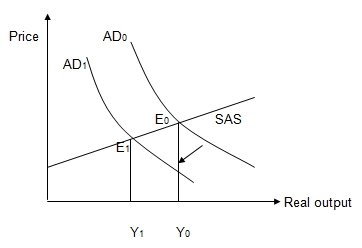
Figure 2: AD-AS Model (shift in SAS curve)
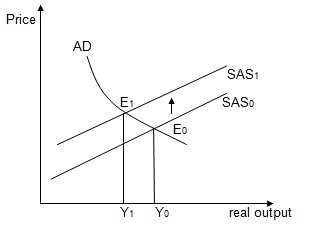
Figure 3: Effect of expansionary fiscal policy
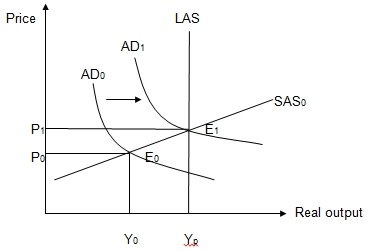
Figure 4: Effect of reduced production costs
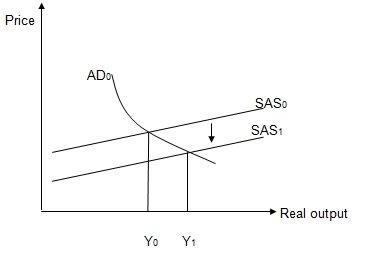
Figure 5: effect of fiscal consolidation
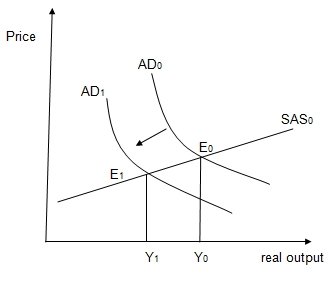
Works Cited
Al-Khateeb, Faisal, Ali Darrat and Khaled Elkhal. “The UAE Growth Surge: Have Information Technology and Human Capital Contributed?” Studies in Economics adn Finance 24.4 (2007): 297-306. Print.
Chamberlin, Graeme, Linda Linda and Yi-Chuang Yueh. Macroeconomics. New York: McGraw-Hill, 2006. Print.
Minford, Patrick and David Peel. Advanced Macroeconomics. New York: John Wiley and Sons, 2002. Print.
Nyarko, Yaw. The United Arab Emirates. Business. New York: UNU-WIDER, 2013. Print.
Romer, David. Advanced Macroeconomics. New York: McGraw-Hill, 2011. Print.
Rossana, Robert. Macroeconomics. London: Oxford University Press, 2011. Print.
World Bank. UAE Economic Indicators. World Bank Group, 31 Dec. 2012. Web.